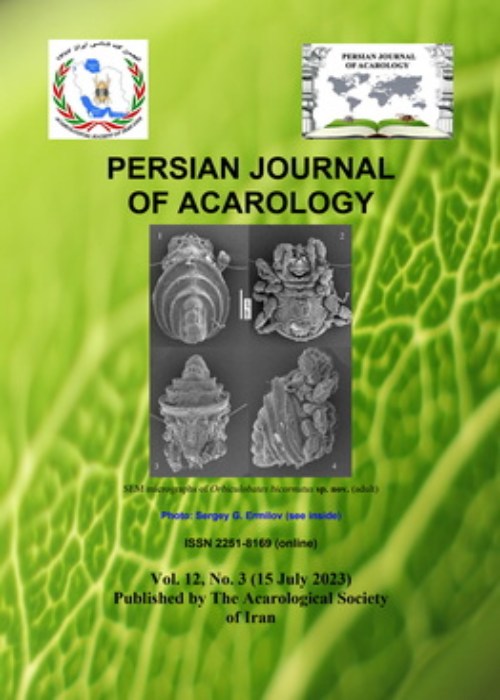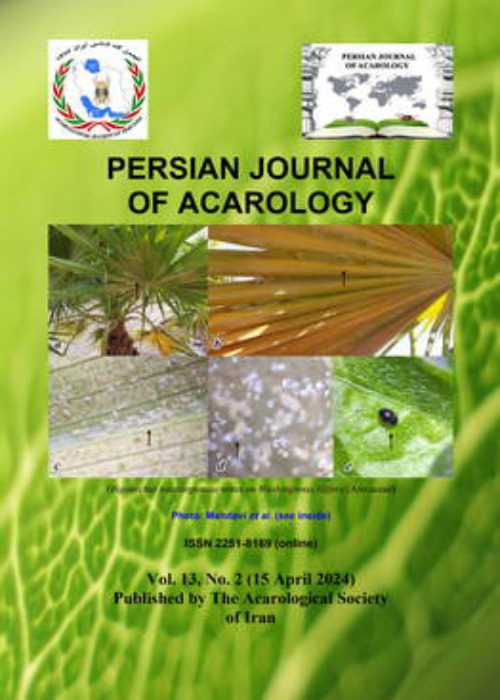فهرست مطالب

Persian Journal of Acarology
Volume:12 Issue: 3, Summer 2023
- تاریخ انتشار: 1402/06/16
- تعداد عناوین: 7
-
-
صفحات 377-384
-
Pages 377-384
A new species of the genus Pergalumna, P. rooensis sp. nov. is described from leaf litter in secondary semi-evergreen tropical forest in Mexico. The new species can be distinguished from the related species P. makarovae in the body size, the length of lamellar seta, the morphology of head of the bothridial seta, and the localization of notogastral lyrifissure im. Pergalumna silvatica Hammer, 1961 is recorded in Mexico for the first time.
Keywords: Galumnid mites, morphology, Neotropical region, new record, taxonomy -
Pages 385-392
A new Anthocoptini mite, Tetra hajiqanbari Lotfollahi & Jafari sp. nov. was discovered and described in the Lorestan province of Iran. The mites were vagrant on leaves of Glycyrrhiza glabra L. (Fabaceae). This is the fourth eriophyoid species found on this host plant.
Keywords: Anthocoptini, Glycyrrhiza, Lorestan, Phyllocoptinae, vagrant -
Pages 393-402
The genus Orbiculobates (Oribatida, Plasmobatidae) is recorded in Mexico for the first time. A new species — O. bicornutus sp. nov. — is described, based on adults collected from leaf litter in secondary semi-evergreen tropical forest. An identification key to the known species of Orbiculobates is presented.
Keywords: Key, Mexico, morphology, plasmobatid mites, taxonomy -
Pages 403-415
To identify eriophyoid mites, sampling was done on dominant plants of Hesar village in Meshginshahr region of the Ardabil province during summer 2020. Two families, five subfamilies, five tribes, 12 genera and 27 species were identified among which Cecidophyopsis hesariensis Lotfollahi & Hemmatzadeh sp. nov. collected on the host plant Lonicera iberica M. Bieb. (Caprifoliaceae) was new to science and the second Cecidophyopsis species found on plants of the family Caprifoliaceae. Three species including Aculus salicisincanae (Nalepa, 1925), Aceria peucedani (Canestrini, 1892) and Aculus eurynotus (Nalepa, 1894) were new reports for Iran. A list of identified taxa is provided with comments and 22 species were reported for the first time in Ardabil province.
Keywords: Aceria, Aculus, Ardabil, Caprifoliaceae, Cecidophyopsis -
Pages 417-430
Neocarus comprises a genus with a wide range of distribution in the Americas, having occurrences from the southern United States to Argentina. In this context, Brazil is a region with great biodiversity where 17 species of this genus have been described up to now. The present description emphasizes the great biodiversity of Opilioacarida found in Brazil, and the new species, Neocarus kayapo sp. nov. that differs from the others by presenting multiple setae cht (2–4) at the base of both male and female chelicera, and also by the presence of two lateral opposite projections on the ovipositor, clearly a set of features that are unique among the species of the genus Neocarus.
Keywords: Cerrado, free-living, hypogean, Neotropical region, Opilioacarida, Parasitiformes -
Pages 431-438
The new eriophyid species, Phyllocoptes khazariensis sp. nov. was found on Cupressus sempervirens L. (Cupressaceae) during a survey on eriophyoid mite fauna of Sari county, Mazandaran province, north of Iran, in summer 2017. This is the first Phyllocoptes species found on plants of the genus Cupressus and herein described and illustrated.
Keywords: Eriophyidae, Mazandaran, new species, Phyllocoptinae, Phyllocoptini -
Pages 439-453
Population fluctuation of the most abundant mite species inhabiting mango, Mangifera indica L. (Anacardiaceae), as one of the important fruit trees at Qalyubia governorate, Egypt was studied from August 2020 to September 2022. Results indicated the occurrence of 19 mite species from 18 genera in 10 families. Mango bud mite, Aceria mangiferae Sayed, mango rust mite, Metaculus mangiferae (Attiah) and tetranychid mite, Oligonychus mangiferus (Rahman & Sapra) have become important pests on “Naomi” mango cultivar. While, the mango leaf coating mite, Aceria aegyptindicae Elhalawany, Amrine & Ueckermann and Cisaberoptus kenyae Keifer are important pests on “Heidi” cultivar. Aceria mangiferae has two peaks (in mid and late November, and late May and early-June) on buds of “Naomi” cultivar during the two successive seasons. Metaculus mangiferae has two peaks on leaves (in mid-October and late May) in the first season and (in late November and May) in the second season. Oligonychus mangiferus was recorded in high numbers in spring and autumn on “Naomi” cultivar during the two collection seasons. Aceria aegyptindicae and C. kenyae have two peaks (in late November and mid-February) in the first season, and (in early December and late April) in the second season on “Heidi” cultivar. Predacious mites are following their associated phytophagous prey with a lag in time. The population of phytophagous mites was significantly affected by combined weather factors and plant age than weather factors alone. Results indicated ‘Heidi’ is resistant to infestation with A. mangiferae, and susceptible to both A. aegyptindicae and C. kenyae. However, ‘Naomi’ is susceptible to the first pest and resistant to latter two pests. The changes in the nutritional value of the host plant are more effective on mite population fluctuation than weather factors.
Keywords: Incidence, phenology, plant-feeding mites, predatory mites, weather factors


